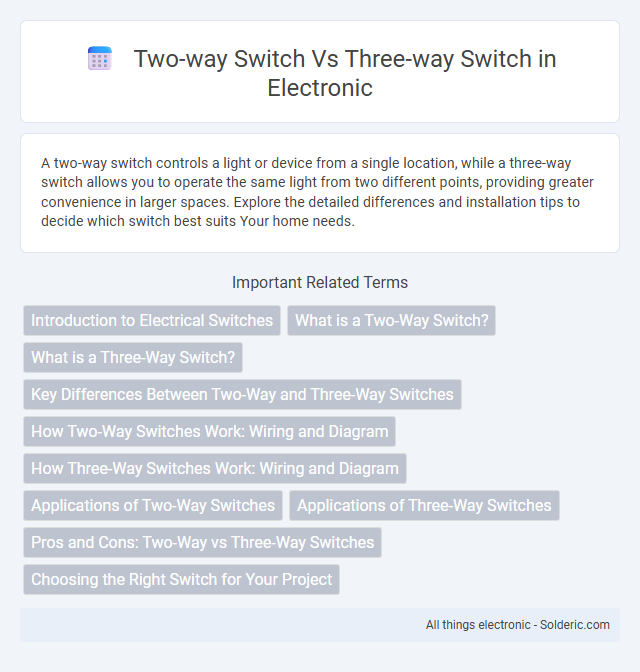A two-way switch controls a light or device from a single location, while a three-way switch allows you to operate the same light from two different points, providing greater convenience in larger spaces. Explore the detailed differences and installation tips to decide which switch best suits Your home needs.
Comparison Table
| Feature | Two-Way Switch | Three-Way Switch |
|---|---|---|
| Function | Controls a light or device from a single location | Controls a light or device from two different locations |
| Number of Switches | One switch per circuit | Two switches per circuit |
| Wiring Complexity | Simple wiring, fewer wires needed | More complex wiring, requires traveler wires |
| Common Usage | Single room or area lighting control | Hallways, staircases, or large rooms with multiple entrances |
| Cost | Lower cost due to simpler design | Higher cost due to additional components |
| Installation Difficulty | Easy to install for beginners | Requires electrical knowledge or professional installation |
Introduction to Electrical Switches
Two-way switches control a single electrical fixture from two different locations, commonly used in stairways or long hallways. Three-way switches enable control of the same fixture from three or more locations with an additional controller, often found in large rooms or corridors. Understanding the wiring differences and applications of two-way versus three-way switches is essential for proper electrical system design and installation.
What is a Two-Way Switch?
A two-way switch controls a light or device from a single location using two terminals to complete or break the circuit. Commonly used in simple lighting setups, it allows you to turn your lights on or off from one switch position. Two-way switches are ideal for rooms where only one control point is needed, unlike three-way switches that enable control from multiple locations.
What is a Three-Way Switch?
A three-way switch allows control of a single light or electrical fixture from two different locations, making it ideal for hallways, staircases, and large rooms. Unlike a two-way switch, which controls a light from one spot, a three-way switch uses two switches connected by traveler wires to enable on/off functionality from either switch. This setup enhances convenience and improves home lighting control without the need for additional wiring complexity.
Key Differences Between Two-Way and Three-Way Switches
Two-way switches control a light or device from a single location, featuring two terminals and a straightforward on/off function. Three-way switches allow you to control the same light or device from two different locations, commonly using three terminals to enable this functionality. Your choice depends on the complexity of the wiring setup and the number of control points needed for convenience in your space.
How Two-Way Switches Work: Wiring and Diagram
Two-way switches control a light or device from two different locations using two switches connected in series with the load through traveler wires. The wiring involves two traveler wires running between the switches and a common terminal on each switch, allowing the current path to be altered, thereby turning the light on or off from either switch. Standard diagrams show the line (live) wire connected to the common terminal on the first switch, traveler wires linking the two switches, and the load connected to the common terminal of the second switch.
How Three-Way Switches Work: Wiring and Diagram
Three-way switches operate by allowing control of a single light fixture from two separate locations using a pair of three-terminal switches connected with traveler wires. The wiring involves a common terminal connected to the power source or light fixture and two traveler terminals that carry current between switches, enabling the light to be turned on or off from either switch. A typical diagram illustrates the line wire connected to the common terminal of the first switch, traveler wires linking the traveler terminals of both switches, and the load connected to the common terminal of the second switch.
Applications of Two-Way Switches
Two-way switches are commonly used for controlling a single light fixture from two different locations, such as at the top and bottom of a staircase or at both ends of a hallway. These switches enable convenient on/off control without the need for complex wiring, making them ideal for residential settings. Their simple design supports circuits with two switch positions, enhancing usability in straightforward lighting control applications.
Applications of Three-Way Switches
Three-way switches are commonly used in settings where controlling a single light or device from two different locations is necessary, such as at the top and bottom of staircases or in long hallways. These switches enable seamless control and enhance convenience by allowing you to toggle lighting without returning to a single switch point. Their application in complex lighting systems provides increased flexibility and safety in residential and commercial environments.
Pros and Cons: Two-Way vs Three-Way Switches
Two-way switches offer simplicity and ease of installation, ideal for single locations controlling a light, but lack flexibility in multi-entry setups. Three-way switches provide the advantage of controlling lights from two locations, enhancing convenience in hallways or large rooms, though they require more complex wiring and slightly higher costs. Your choice depends on whether you prioritize straightforward installation or versatile control points for lighting.
Choosing the Right Switch for Your Project
Choosing the right switch for your project depends on the control points needed; a two-way switch is ideal for controlling a single light from one location, while a three-way switch allows you to control the same light from two different locations, enhancing convenience and flexibility. Understanding the wiring complexity and functionality of each switch type ensures your electrical setup meets your practical requirements and safety standards. Selecting the correct switch will optimize your home's lighting control and improve user experience.
two-way switch vs three-way switch Infographic

 solderic.com
solderic.com